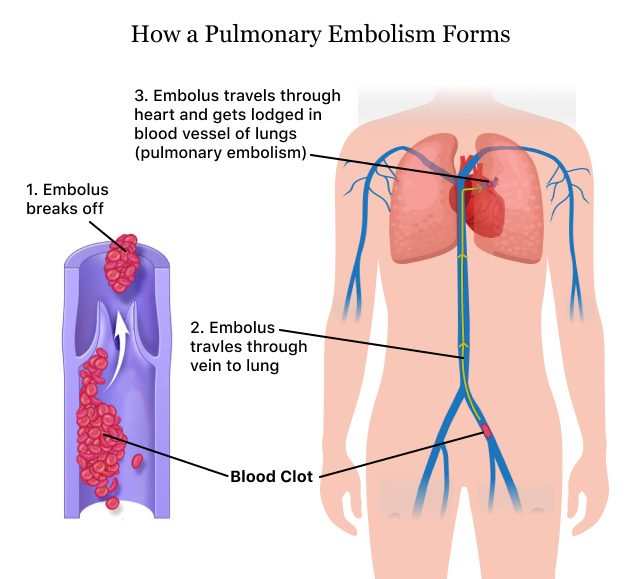Deep vein thrombosis DVT is a medical condition that occurs when a blood clot develops deep in a vein. When traveling long distances people may be concerned about a type of blood clot known as a deep vein thrombosis DVT.

How Much Do You Know About Deep Vein Thrombosis Laser Vein Center Vein Thrombosis Deep Vein Thrombosis Thrombosis
A blood clot that blocks an artery to the brain can cause a stroke.

A traveling blood clot is called. When a blood clot travels to the lungs and causes a blockage of an artery its called a pulmonary embolism. More than 300 million people travel on long-distance flights generally more than four hours each year. When the blood clot occurs in a deep vein it is called deep vein thrombosis or DVT.
A thrombus or embolus can partly or completely block the flow of blood in a blood vessel. 1 Blood clots also called deep vein thrombosis DVT can be a serious risk for some long-distance travelers. This leads to slowing and even pooling of the blood especially in the abdomen and lower extremities.
In fact the types of blood clots that people can develop on airplanes such as deep vein thrombosis are totally different from the rare blood clots a small number of people developed after receiving certain COVID-19 vaccines according to Dr. A blood clot that forms inside one of your veins or arteries is called a thrombus. A thrombus may also form in your heart.
Haut associate professor of surgery and a deep vein thrombosis expert at Johns. So it works by preventing the platelets from forming blood clots. Drugs called thrombolytics may be used if your blood clots are the result of a.
Most information about blood clots and long-distance travel comes from information that has been gathered about air travel. More than 300 million people travel on long-distance flights generally more than four hours each year. Most often they form in the legs though they can.
1 Blood clots also called deep vein thrombosis DVT can be a serious risk for some long-distance travelers. A clot that travels to your brain can cause a. An abnormal clotting condition called thrombosis arises when blood cells produce clots that travel through the bloodstream causing vessels to clog.
There are three typesvenous thromboembolism pulmonary embolism and coronary thrombosis. The danger of DVT comes when pieces of the clot known as emboli break off and travel through the bloodstream to an artery. Most information about blood clots and long-distance travel comes from information that has been gathered about air travel.
1 Blood clots also called deep vein thrombosis DVT can be a serious risk for some long-distance travelers. 1 Blood clots also called deep vein thrombosis DVT can be a serious risk for some long-distance travelers. More than 300 million people travel on long-distance flights generally more than four hours each year.
As many as one of every 1000 Americans develops DVT each year. More than 300 million people travel on long-distance flights generally more than four hours each year. If you have a history of blood clots or have recently been treated for them your risk of developing a PE or DVT while flying.
Flying with a blood clot or history of clots. That means they dont move. A thrombus that breaks loose and travels from one location in the body to another is called an embolus.
Blood clots are also known as deep vein thrombosis as they typically form in the deep veins of the body that arent visible through the skin. Blood clots can be stationary. Doctors call this type of clot a thrombosis.
But they can block blood flow. Most information about blood clots and long-distance travel comes from information that has been gathered about air travel. These clots typically occur in a leg a.
Venous thromboembolism occurs in veins or arteries most commonly in the legs. Blood clots prevent the flow of blood in blood vessels robbing parts of the body of oxygen and nutrients. Blood clots are formed when blood is sluggish or constricted such as when seated in an upright position with the knees bent and the hips stuck at 90-degree angles for extended periods of time.
Prevent blood clots while traveling. Most information about blood clots and long-distance travel comes from information that has been gathered about air travel.

Pulmonary Embolism Pe Causes Of A Blood Clot In The Lung

Pin En Graphics For World Thrombosis Day

Pin By Emma Peters On Thrombosis Dvt Med Surg Nursing Deep Vein Thrombosis Thrombosis

Pin On Peripheral Vascular Lymphatic

Pin On Blog Emerson Villela Carvalho Jr M D

World Thrombosis Day On Twitter Pulmonary Embolism Awareness Thrombosis Health Tips




0 comments:
Post a Comment